Sowing dates - Getting the best from our varieties and optimising whole-farm wheat yield (NSW)
Sowing dates - Getting the best from our varieties and optimising whole-farm wheat yield (NSW)
Author: James Hunt, Neil Fettell, Jon Midwood, Annieka Paridaen, Julianne Lilley, Paul Breust, Rohan Brill, Brad Rheinheimer and John Kirkegaard | Date: 27 Feb 2013
James Hunt1, Neil Fettell2, Jon Midwood3, Annieka Paridaen3, Julianne Lilley1, Paul Breust4, Rohan Brill5, Brad Rheinheimer1 and John Kirkegaard1
1CSIRO, 2University of New England, 3SFS, 4FarmLink Research and 5NSW DPI
GRDC project code: CPS00111, SFS00018
Keywords: time of sowing, wheat, water-use efficiency
Take home messages
- Very slow or slow maturing wheat varieties sown mid-late April and managed for high harvest index (HI) on average yield 0.8 t/ha more than mid-fast varieties sown mid-May.
- Simulations show that including a slow maturing variety in a farm program greatly increases average farm wheat yield (13-47%) and reduces risk.
- Know the optimal flowering window in your location and how to achieve it with different varieties from different sowing dates to optimise whole-farm wheat yield.
- Yield penalties for sowing too late are generally higher than for sowing too early, even at frosty sites.
Background
In southern Australia, April-May rainfall has declined due to movement in the position of the sub-tropical ridge, a consequence of ozone depletion and/or global warming due to greenhouse gas emissions (http://www.grdc.com.au/Media-Centre/Ground-Cover/Ground-Cover-Issue-101/Expanding-subtropic-zone-the-clue-to-dry-autumns). Rain during this time is critical for establishing the currently popular mid-fast spring wheat varieties so that they flower at a time optimal for yield. Also, larger farm sizes and cropped area mean that contemporary sowing programs often exceed the available sowing opportunities. Extreme weather during spring has made achieving timely flowering of cereal crops increasingly critical to yield and farm profitability.
An opportunity exists to overcome this challenge by using rain which falls during the summer and early autumn fallow period to establish wheat crops much earlier than is currently practiced. At some locations in the region, the proportion of rain falling during the summer fallow period has increased, and growers are placing more emphasis on conserving the resource through complete control of summer fallow weeds and wide adoption of no-till seeding systems. No-till allows much earlier planting into more marginal moisture, more deeper (‘moisture seeking’) planting and more planting in response to smaller rainfall events. However, planting currently grown varieties in early autumn incurs unacceptable frost risk due to early flowering. Consequently, for this change to happen, planting of slow maturing varieties with either stronger vernalisation (winter wheats) or photo-period requirements (slow maturing spring wheats) will be necessary. Fortunately such varieties exist, but are currently undervalued and rarely used by producers as they are sown too late in national variety trials (NVT) for their yield and quality potential to be fully expressed.
The aim of these experiments was to see how slow maturing, milling quality spring wheats sown early into stored soil water, yield in comparison to mid-fast varieties sown during the usual sowing window.
What we did
We used APSIM simulations 1890-2009 with a multiplier on yield for frost and heat damage to identify optimal flowering windows at three different locations with contrasting climates (Lake Bolac/Westmere Vic – high rainfall, Temora/Junee NSW – medium rainfall and Condobolin NSW – low rainfall). Optimal flowering dates for wheat in each environment were 23 October at Lake Bolac, 28 September at Temora/Junee and 16 September at Condobolin (Figure 1).
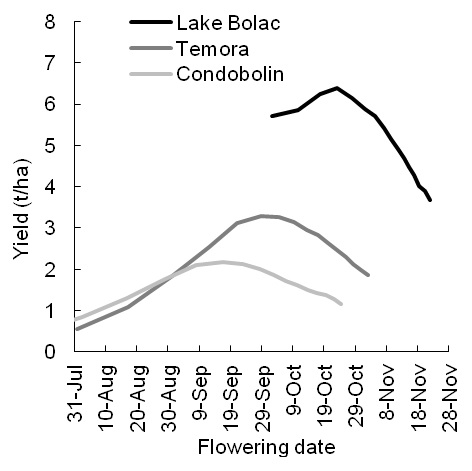
Figure 1. Mean flowering date (Z65) and yield at each location from 120 year (1890-2009) APSIM simulation with a multiplier applied to yield for heat and frost.
In each location, we established experiments with commercially available and locally adapted spring milling wheat varieties of varying maturity sown at different dates such that they flowered on the same optimal date identified by APSIM. Maturity groups were classified as ‘very slow’ (Forrest at Lake Bolac/Westmere and EGA Eaglehawk
at Lake Bolac/Westmere and EGA Eaglehawk at Temora/Junee and Condobolin), ‘slow’ (Bolac
at Temora/Junee and Condobolin), ‘slow’ (Bolac at all sites), ‘mid’ (Derrimut
at all sites), ‘mid’ (Derrimut at Lake Bolac/Westmere and EGA Gregory
at Lake Bolac/Westmere and EGA Gregory at Temora/Junee and Condobolin), ‘fast’ (Lincoln
at Temora/Junee and Condobolin), ‘fast’ (Lincoln at all sites) and ‘very fast’ (Axe
at all sites) and ‘very fast’ (Axe at Condobolin 2011 only). Sowing date of the different maturity classes required to achieve optimal flowering date was consistent across environments. Optimal sowing date for the very slow maturity group was 15 April with optimal sowing dates for subsequent groups being progressively ten days afterward (slow – 25 April, mid – 5 May, fast – 15 May, very fast 25 May). Experimental sowing dates deviated from these somewhat, but flowering of the different maturity classes largely coincided at all locations (Table 1).
at Condobolin 2011 only). Sowing date of the different maturity classes required to achieve optimal flowering date was consistent across environments. Optimal sowing date for the very slow maturity group was 15 April with optimal sowing dates for subsequent groups being progressively ten days afterward (slow – 25 April, mid – 5 May, fast – 15 May, very fast 25 May). Experimental sowing dates deviated from these somewhat, but flowering of the different maturity classes largely coincided at all locations (Table 1).
Table 1. Experimental sowing and anthesis dates (Z65 – 50% of ears flowered) for the different maturity groups at each location in 2011 and 2012.
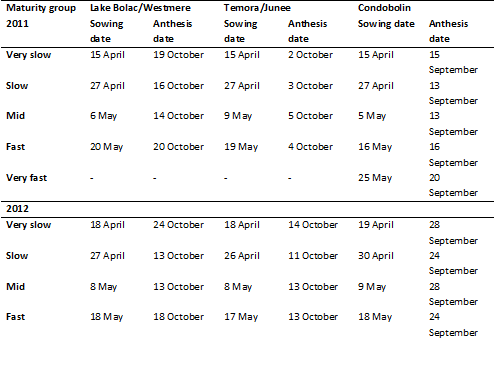
We also applied regionally relevant management treatments intended to avoid excessive vegetative growth and increase HI, which included very low plant densities (Temora/Junee, Condobolin, Lake Bolac), plant growth regulators (PGRs - Lake Bolac and Temora 2011), defoliation (to simulate grazing) at Z30 (Junee and Condobolin 2012) and sub-soil manuring (Lake Bolac 2011).
What we found
At Temora in 2011 there was a large yield advantage (0.8 t/ha) from sowing a very slow variety early (EGA Eaglehawk 15 April) and reducing seeding rate to improve HI (6.3 t/ha) compared to sowing mid and mid-fast varieties in their optimal window (EGA Gregory
15 April) and reducing seeding rate to improve HI (6.3 t/ha) compared to sowing mid and mid-fast varieties in their optimal window (EGA Gregory 9 May 5.4 t/ha, Lincoln
9 May 5.4 t/ha, Lincoln 19 May 5.5 t/ha – Table 2) as currently practiced. There was a yield reduction in mid and mid-fast varieties sown at low densities and there was no effect of PGRs on yield. The yield benefit of the slow varieties may be an under-estimate of the value of early sowing at this site. Seed bed moisture was perfect on 15 April following 16 mm of rain on 10 April, but was becoming marginal on 27 April and by 9 and 19 May irrigation (8 mm applied into press-wheel furrows with drippers) was required to establish the crop.
19 May 5.5 t/ha – Table 2) as currently practiced. There was a yield reduction in mid and mid-fast varieties sown at low densities and there was no effect of PGRs on yield. The yield benefit of the slow varieties may be an under-estimate of the value of early sowing at this site. Seed bed moisture was perfect on 15 April following 16 mm of rain on 10 April, but was becoming marginal on 27 April and by 9 and 19 May irrigation (8 mm applied into press-wheel furrows with drippers) was required to establish the crop.
Therefore in a dry-land farming situation where irrigation would not be possible, the early-sown slow varieties would have had an even greater yield advantage over the later-sown faster varieties as the rain that allowed them to emerge did not fall until 25 May.
Table 2. Grain yield and harvest index of four wheat varieties of different maturity sown at two plant densities at Temora in 2011 to flower on the same date.

At Junee in 2012 there was again a large yield advantage (2.1 t/ha) from sowing a very slow variety early (EGA Eaglehawk 18 April 6.1 t/ha) compared to sowing mid and mid-fast varieties in their optimal window (EGA Gregory
18 April 6.1 t/ha) compared to sowing mid and mid-fast varieties in their optimal window (EGA Gregory 8 May 5.2 t/ha, Lincoln
8 May 5.2 t/ha, Lincoln 17 May 4.0 t/ha – Table 3). Defoliation generally reduced yields, with the exception of Bolac
17 May 4.0 t/ha – Table 3). Defoliation generally reduced yields, with the exception of Bolac at 100 plants/m² and Lincoln
at 100 plants/m² and Lincoln at both densities where the difference was not significant. Reduced plant density generally did not affect yield, but provided a small increase for un-defoliated Bolac
at both densities where the difference was not significant. Reduced plant density generally did not affect yield, but provided a small increase for un-defoliated Bolac and Lincoln
and Lincoln .
.
Table 3. Grain yield of four wheat varieties (not defoliated or defoliated) of different maturity sown at Junee in 2012 to flower on the same date.

Time of sowing data show that there is generally less yield penalty from sowing earlier than is optimal, despite both sites experiencing frosts around anthesis (Figures 2 and 3). At Temora in 2011, the highest yields achieved at each time of sowing had 5% frost damage (Figure 2).

Figure 2. Grain yield of different varieties at Temora in 2011 sown at 100 plants/m² with no PGRs. Numbers next to data points are % frost-induced sterility.
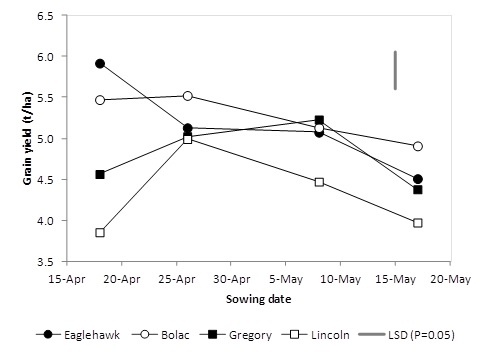
Figure 3. Grain yield of different varieties at Junee in 2012 sown at 100 plants/m² and not defoliated. Frost induced sterility data not available at time of publication.
At Condobolin in 2011, dry conditions in late winter reduced grain set in the earliest sowings and similar yields were obtained from sowing dates ranging from 15 April until 16 May. The higher biomass from sowing earlier was offset by a lower HI (Table 4), even at a low plant density. Whilst there was an increase in HI and yield at low plant densities for slow maturing varieties sown early (EGA Eaglehawk , Bolac
, Bolac ), there was a yield penalty at low plant densities for fast maturing varieties sown later (Lincoln
), there was a yield penalty at low plant densities for fast maturing varieties sown later (Lincoln , Axe
, Axe ).
).
Table 4. Grain yield and harvest index of five wheat varieties of different maturity sown at two plant densities at Condobolin in 2011 to flower on the same date.
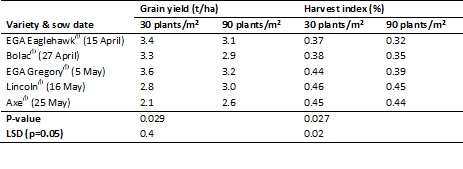
At Condobolin in 2012, the highest yield using the traditional seeding rate was achieved from sowing Bolac on 30 April. Biomass production from the 19 April sowing was equally high but was negated by a much lower HI (0.26 cf. 0.32). This could be largely offset by a lower seeding rate under which biomass was not reduced but HI was raised to 0.29. Defoliation at Z30 was also successful in raising HI values at all sowing dates but this was countered by lower maturity biomass at all but the latest sowing date.
on 30 April. Biomass production from the 19 April sowing was equally high but was negated by a much lower HI (0.26 cf. 0.32). This could be largely offset by a lower seeding rate under which biomass was not reduced but HI was raised to 0.29. Defoliation at Z30 was also successful in raising HI values at all sowing dates but this was countered by lower maturity biomass at all but the latest sowing date.
Table 5. Grain yield of four wheat varieties (un-defoliated or defoliated) of different maturity sown at Condobolin in 2012 to flower on the same date.

At Lake Bolac in 2011, annual rye-grass resistance to herbicide groups A and B overran the first time of sowing and all low plant density treatments and these have been excluded from analysis. The slow variety Bolac sown on 27 April yielded 7.0 t/ha, the mid variety Derrimut
sown on 27 April yielded 7.0 t/ha, the mid variety Derrimut sown on 6 May yielded 6.6 t/ha and the fast variety Lincoln
sown on 6 May yielded 6.6 t/ha and the fast variety Lincoln sown on 20 May yielded 6.0 t/ha (P=0.006, LSD(P=0.05)=0.6 t/ha).
sown on 20 May yielded 6.0 t/ha (P=0.006, LSD(P=0.05)=0.6 t/ha).
At Westmere in 2012, the highest yields were achieved by the slow variety Bolac sown at its optimal time on 27 April and also at 8 May (Figure 4). The very slow variety Forrest
sown at its optimal time on 27 April and also at 8 May (Figure 4). The very slow variety Forrest flowered later than expected at its optimal time of sowing (Table 1), and did not yield well. However, seed bed moisture at 18 April was poor, and establishment was only 58 plants/m² at that time of sowing compared to 122 plants/m² at the 18 May sowing (target density was 160 plants/m²). Bolac
flowered later than expected at its optimal time of sowing (Table 1), and did not yield well. However, seed bed moisture at 18 April was poor, and establishment was only 58 plants/m² at that time of sowing compared to 122 plants/m² at the 18 May sowing (target density was 160 plants/m²). Bolac and Derrimut
and Derrimut sown 1 May were also the highest yielding treatments in a scaled down version of the experiment at Inverleigh (Figure 5).
sown 1 May were also the highest yielding treatments in a scaled down version of the experiment at Inverleigh (Figure 5).
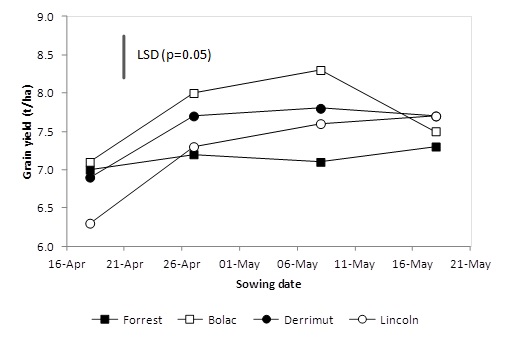
Figure 4. Yields of different varieties at different times of sowing at Westmere in 2012.
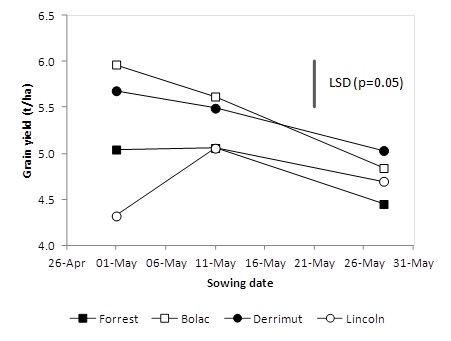
Figure 5. Yields of different varieties at different times of sowing at Inverleigh in 2012
A fourth experiment was planted at Trangie, NSW in the GRDC northern region in 2012, where optimal anthesis date is 18 September. The pre-release line LPB07-0548 was used as a slow maturing variety instead of Bolac , and Spitfire
, and Spitfire was used as a fast maturing variety instead of Lincoln
was used as a fast maturing variety instead of Lincoln . Gregory
. Gregory sown 1 May (prior to its optimal time) achieved the highest yield, and there was no yield advantage in sowing long-season varieties early (Figure 4). However, the first time of sowing (24 April) was too late for Eaglehawk
sown 1 May (prior to its optimal time) achieved the highest yield, and there was no yield advantage in sowing long-season varieties early (Figure 4). However, the first time of sowing (24 April) was too late for Eaglehawk (anthesis date 21 September compared to 17 September for Gregory
(anthesis date 21 September compared to 17 September for Gregory sown 8 May). The first time of sowing also had poor establishment, but it could be argued that this was a treatment effect since establishment can be reduced by higher evaporation rates and warmer soils when sowing early.
sown 8 May). The first time of sowing also had poor establishment, but it could be argued that this was a treatment effect since establishment can be reduced by higher evaporation rates and warmer soils when sowing early.
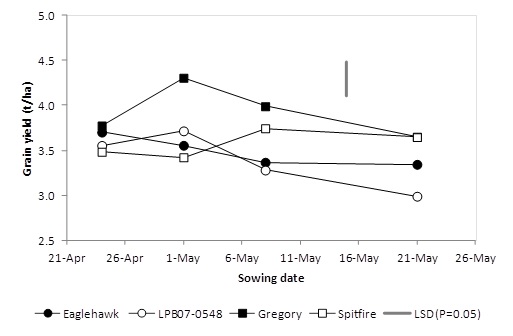
Figure 6. Yields of different varieties at different times of sowing at Trangie in 2012
Why do early sown crops yield more?
Early sown crops yield more for a range of different reasons;
Deeper roots. In situations where the soil profile fills with water, early sown crops yield more because roots grow deeper and use more water (Figure 7). Wheat roots grow at approximately 12 mm/day from germination to anthesis, and early sowing of slow maturing wheats increases this period and thus potential rooting depth.
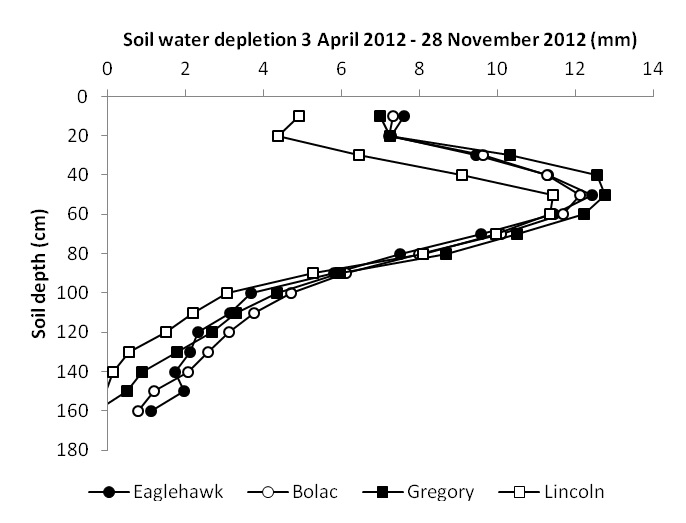
Figure 7. Soil water depletion for the growing season by different varieties sown in their optimal window at Junee in 2012. Total soil water depletion below 100 cm depth was 16 mm for Eaglehawk , 18 mm for Bolac
, 18 mm for Bolac , 13 mm for Gregory
, 13 mm for Gregory and 7 mm for Lincoln
and 7 mm for Lincoln (P=0.001, LSD(P=0.05) = 5 mm).
(P=0.001, LSD(P=0.05) = 5 mm).
2. Less evaporation. Early sown crops also develop their canopy faster (Figure 8) and as a result lose less water to evaporation, and thus water is converted to dry-matter more efficiently (Table 6).
3. Longer yield formation phase. The longer stem elongation phase of early sown slow maturing varieties mean that they intercept more radiation and grow more during this period, which increases grain number and thus yield (Figure 9 and 10).
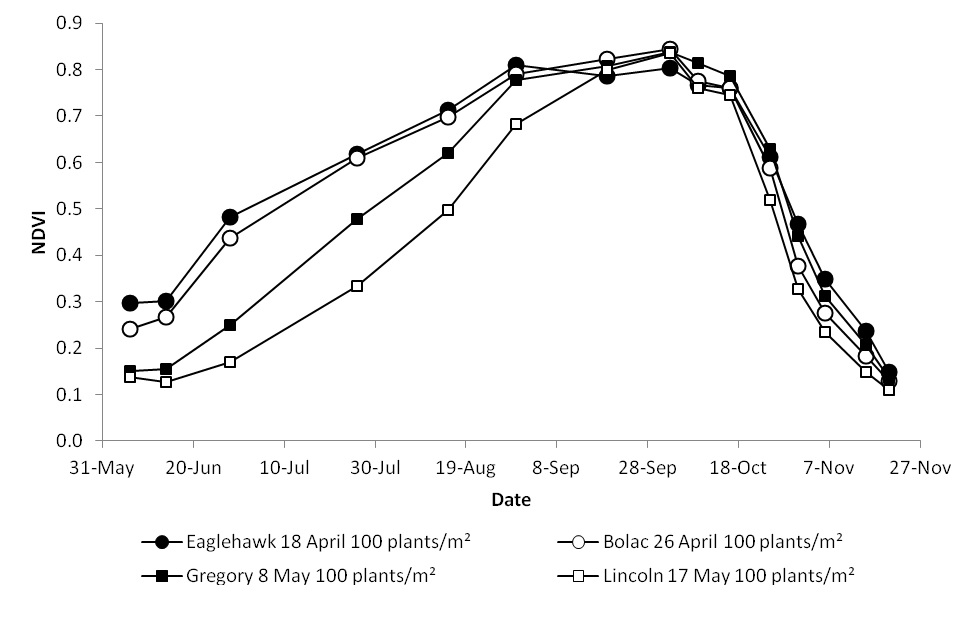
Figure 8. NDVI of different varieties sown in their optimal window during the growing season at Junee in 2012.
Table 6. Crop water-use (evaporation + transpiration), dry matter at maturity (Z92), WUE for dry matter and estimates of transpiration and evaporation for varieties of differing maturity sown in their optimal window at Junee in 2012.

*Transpiration estimated assuming transpiration efficiency for dry matter of 55 kg/ha.mm

Figure 9. The relationship between growth during stem elongation and grain yield at Lake Bolac (●), Temora (○) and Condobolin (■) in 2011.
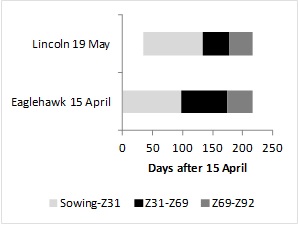
Figure 10. Phase durations for EGA Eaglehawk sown 15 April and Lincoln
sown 15 April and Lincoln sown 19 May at Temora in 2011.
sown 19 May at Temora in 2011.
Advantages at the whole farm scale
Including a slow maturing wheat variety in a farm program increases the frequency of planting opportunities, and allows more crop to be sown and flower on time, increasing average farm yield. We conducted APSIM simulations over 50 years to compare sowing strategies at hypothetical farms at 5 sites in south-eastern Australia. On each hypothetical farm we assumed that the total area of wheat sown in each year takes twenty days to sow (e.g. 20 paddocks each taking 1 day to sow). Other crops were not considered in the simulation, and nitrogen, weeds, disease etc. were assumed not to limit yields, but a reduction for frost and heat damage based on screen temperatures was applied. Yields presented are farm average wheat yield across 50 years, for 20 paddocks sown according to the following strategies.
- Mid-fast varieties only. In this scenario only varieties from the mid-fast maturity group (e.g. Scout
 , Mace
, Mace , Lincoln
, Lincoln , Spitfire
, Spitfire ) were sown. Sowing started on 5 May at the earliest and only if there was seed-bed moisture (i.e. after the autumn break). If the break had not arrived by 25 May, sowing started on that date and finished on 13 June regardless of seed bed moisture.
) were sown. Sowing started on 5 May at the earliest and only if there was seed-bed moisture (i.e. after the autumn break). If the break had not arrived by 25 May, sowing started on that date and finished on 13 June regardless of seed bed moisture. - Slow + mid-fast varieties. In this scenario two varieties of differing maturity were grown on the farm – very slow (e.g. Wedgetail
 , Forrest
, Forrest , Eaglehawk
, Eaglehawk – sown 10 April to 4 May), and mid-fast (e.g. Scout
– sown 10 April to 4 May), and mid-fast (e.g. Scout etc. – 5 May onward). Each variety was sown within its appropriate window, but only if there was seed-bed moisture, and in the case of the slow variety, only if there was also 25 mm of stored soil water in the top 25 cm of the profile. If the break had not arrived before 25 May, sowing started on that date and finished on 13 June and only the mid-fast variety was sown. In this scenario the area sown to each variety changed from year to year based on rainfall pattern e.g. if the break fell by 15 April, 100% of the farm was sown to the slow variety. If the break fell on 5 May or later, only the mid-fast variety was sown.
etc. – 5 May onward). Each variety was sown within its appropriate window, but only if there was seed-bed moisture, and in the case of the slow variety, only if there was also 25 mm of stored soil water in the top 25 cm of the profile. If the break had not arrived before 25 May, sowing started on that date and finished on 13 June and only the mid-fast variety was sown. In this scenario the area sown to each variety changed from year to year based on rainfall pattern e.g. if the break fell by 15 April, 100% of the farm was sown to the slow variety. If the break fell on 5 May or later, only the mid-fast variety was sown.
At all locations average farm yield was significantly increased and production risk reduced if slow varieties were included in the sowing program (Table 7).
Table 7. Including a very slow maturing wheat variety in a farm program that allows early sowing increases average farm yield and reduces risk. Results are from APSIM simulation 1962-2011 with a frost & heat multiplier for yield and assume a farm wheat program takes 20 days to sow.

Whilst growers may cringe at the prospect of keeping seed of multiple varieties on hand to sow an unknown area of crop each year, the yield benefits are substantial. The % area which was sown to the slow variety was often high, indicating that sowing opportunities for slow maturing wheats are quite frequent. The analysis also highlights a significant opportunity for breeding companies willing to focus on development of slow maturing wheats of milling quality, particularly photoperiod insensitive winter wheats.
Putting it into practice
If planning to sow early, the most important thing is to know the optimal flowering window in your location and how to achieve it using different varieties from a broad range of sowing dates. There are three basic strategies for achieving an optimal flowering time;
- Plant winter wheats from early-March to mid-April
- Plant slow maturing spring wheats from mid to late April
- Plant mid-fast varieties from late April into May
The first two strategies require some stored soil water to be present (25 – 30 mm plant available water – use a shovel to check if soil is wet to at least 30 cm on most soil types). These crops must germinate and emerge when they are sown. Winter and slow maturing spring wheats will flower too late if they do not establish before the end of April. Choose paddocks that are relatively weed-free, and therefore, do not require a good knock-down for grass weed control. If sowing early into high soil N, reduce seeding rates.
Best-bet milling wheat varieties for early sowing in southern NSW are listed in Table 8.
Be aware that some diseases can be exacerbated by early sowing e.g. barley yellow dwarf virus (BYDV), wheat streak mosaic virus, Septoria tritici, take-all. Seed-dressed imidicloprid (Gaucho®, Emerge®) protects against BYDV, and flutriafol in-furrow (Impact®, Intake®) protects against take-all and Septoria tritici. ForrestA has putative resistance to WSMV.
Contact details
James Hunt
CSIRO Plant Industry - GPO Box 1600 Canberra ACT 2601
02 6246 5066
